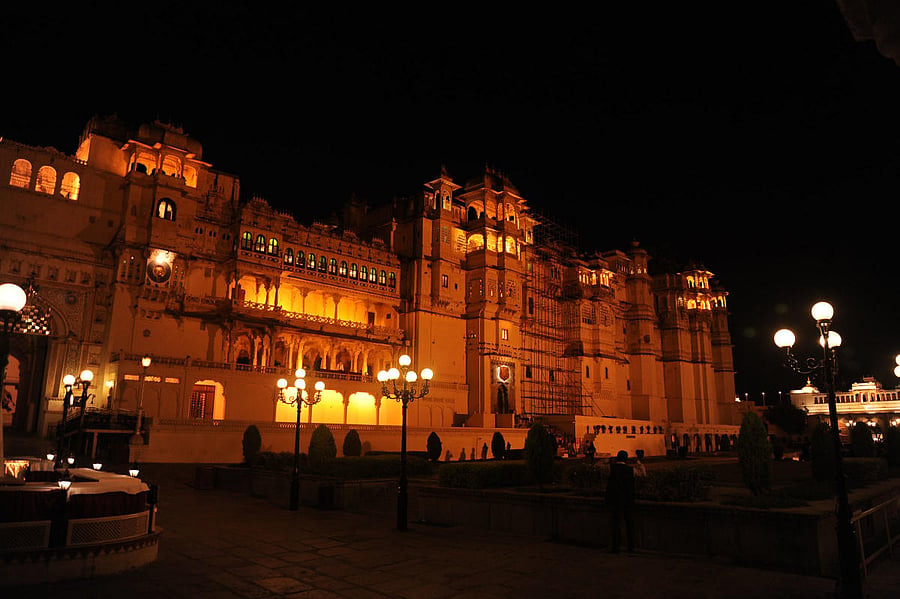
Romantic and whimsical, Udaipur’s charm took us by surprise and we fell in love with it at first sight. Udaipur is a tourist’s paradise and an explorer’s delight.
Also known as the ‘Venice of the East’, and ‘City of Lakes’, Udaipur is home to magnificent fairy-tale palaces, ornate architecture, temples, narrow lanes, colourful bazaars, cobalt blue water lakes, stunning sunsets, boat rides, live cultural shows, lip-smacking cuisine and much more…
This Jewel of Mewar was once the epicentre of heroism, valour and chivalry and was ruled by the Sisodia dynasty for 1,200 years.
The City Palace had just opened at 9.30 am when we bought the entry tickets. A majestic architectural marvel towering over Lake Pichola on a hill surrounded by crenellated walls, City Palace is the pride of Udaipur. It is a conglomeration of mini palaces, courtyards, pavilions, terraces, corridors, luxury rooms and hanging gardens interconnected by a network of passages. In total enclosure, the edifice is 30 metres in height, 333 metres in length and 90 metres in width. Each mini palace in this complex has its own glorious history.
While Maharana Udai Singh was looking for a place to establish his new capital of Mewar, he met an ascetic Goswami Prem Giriji Maharaj on a secluded hill. The holy man advised the Maharana to build a palace here.
The Nav Chowki (nine-section) Mahal is the meeting place of the Maharana and the ascetic. Rai Angan is the place where the Maharana started building the palace on the top of a hill in AD 1559, and laid the foundation of Udaipur. Shiva Prasanna Amar Vilas Palace (Badi Mahal) is the highest point of the complex, on top of the hill, and was built during the reign of Maharana Amar Singh II, in AD 1699. This garden with 104 intricately fluted columns reminiscent of the Mughals’ elements was used for hosting royal banquets on Holi, Diwali and Dussehra. The natural light filtering through the red and green windows of Dilkhushal Mahal (AD 1710-34) created a magical effect in the interiors, as we roamed around taking pictures.
Manek Mahal (Ruby Courtyard) and Kanch ki Buj are adorned with miniature glass inlay work and mirror tiles. Mewar paid its rich homage to peacock, long before we made it our national bird! The Mor Chowk (Peacock Courtyard, AD 1620-28) has finely crafted peacocks in bright mosaic relief, made of 5,000 pieces of Belgium glass and miniature-mirrors. Maharana Sajjan Singh (1874-1884) got the peacocks placed here in the 19th century. In the evening, we took a boat-ride in Lake Pichola.
The sinking sun dusted the palaces with gold as the ride rewarded us with splendid views of the whole complex and the picturesque ghats. Entry is not allowed into Lake Palace for common tourists. So our boat moved past the royal palace and took us to Jag Mandir.The Jag Mandir (built by Maharana Jagat Singh I in AD 1620) has a row of marble elephants which give the impression of guarding the island palace. The palace had served as a shelter for Mughal Prince Khurram (who later became Emperor Shahjahan) in AD 1623-24 when he revolted against his father Emperor Jahangir. Khurram is said to have conceived the design of Taj Mahal, in its miniature form, during his calm and peaceful stay here.
It was time to travel back in time and rewind the glorious history of Mewar. We were seated in the Manek Chowk palace, while the moon and the stars created a canopy of heavenly illumination above us, and flocks of pigeons settled on the main entrance.
The sounds of the tinkling bells and the cries of the soldiers in the battlefield are so carefully crafted into the show that we felt like witnessing all those momentous events in our mind’s eye. In the end, the entire palace was lit up in bright golden light. It was a sight to behold.
Next day, we chose the early morning hours for visiting Sahelion ki Bari (Garden of Maids, AD 1710-34), one of the most beautiful gardens in India. It is so called because the princess and the royal ladies used to come here for a leisurely walk.
It was built by Maharana Sangram Singh II in the mid-18th century for 48 young ladies-in-waiting sent to the royal home, as part of dowry. A puppet show at the Bharatiya Lok Kala Mandal provided wholesome fun and entertainment for us. The museum was founded in AD 1952 by late Padmashri Devilal Samar. Traditional costumes, ornaments, puppets, masks, dolls, miniature paintings and many other art objects are displayed here to give an idea of the folk heritage of our country.
Bagore ki Haveli has over 100 rooms, housing a rich collection of costumes and modern art.
The corridors of its Neem Chowk were lit up with prismatic colours, and the hall was packed to its full capacity. The blowing of the conch, beating of drums and the song Kesariya Balam announced the start of the cultural dance show ‘Dharohar’. It offered a cultural immersion in the local heritage and enveloped us in the colours of Rajasthan. What a fantastic show it was!
Udaipur is a shopper’s paradise and its colourful bazaars are stuffed with exquisite gold ornaments, folk silver jewellery, hand-dyed fabrics, embroidered textiles, miniature paintings, puppets and many other interesting buys. We took a stroll on the Hathi Pol Bazar, Bada Bazar, and Lake Palace Road and returned with a handful of souvenirs and embroidered textiles.
Lake Pichola and its surroundings have a magnetism of their own, and we were drawn to it again and again. We sat on the steps of Gangaur Ghat, and the placid waters of the lake gently washed our feet, while a folk musician played a tune on his instrument.
The night unfurled above us like a star-studded sheet of calm and far away the Jag Mandir was glowing in dim golden radiance, casting a spell on Lake Pichola.